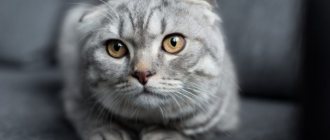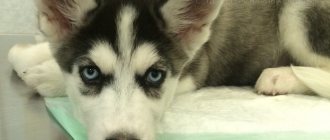Allergies to cats are no more common in people than allergies to dogs. There is a misconception that the fur of your favorite fluffies is to blame. Allergic reactions actually occur to the Fel D1 protein, which is found in animal saliva, urine, sebum, sweat and urine. It doesn’t matter whether your pet has fur or not, there is no escape from physiological secretions.
There are hypoallergenic cats in the world that secrete a minimal amount of protein, which allows allergy sufferers to comfortably live with them in the same living space. In this article we will tell you about the breeds that people who are allergic to animals should pay attention to.
Causes of allergies to cats
Many people mistakenly think that the cause of allergies is animal fur, but in fact, allergies are caused by the Fel D1 protein (Laden allergen), which is found absolutely in the physiological secretions of cats: in saliva, sweat, urine, sebum. While licking, the cat transfers protein particles to the animal's fur, and the hairs, in turn, are spread throughout the room.
Reference. The Fel D1 protein is extremely persistent and remains in the environment for up to six months, even if the cat no longer lives in the house.
Scientists note that true allergies to cat hair are extremely rare . At the same time, about 15% of the world's population suffers from allergies to animals. If your body breaks out in an itchy rash when you come into contact with a cat, but you calmly wear a wool coat, then the cause of the allergic reaction lies in the irritant protein.
Symptoms of a cat allergy:
- rhinitis;
- swelling of the nasal mucosa;
- itching and burning in the throat and nose;
- sneezing,
- dyspnea,
- cough,
- swelling of the nasopharynx;
- dryness, itching and burning of the skin;
- rash and blisters on the skin;
- stomach ache;
- nausea;
- inflammation of the conjunctiva, excessive lacrimation,
- lethargy, irritability, headache.
Signs of allergies are varied and appear with different intensities .
Much depends on the characteristics of the human body and the cat breed.
Which cats are suitable for asthmatics and allergy sufferers?
As already noted, when choosing a breed for sensitive people, you should base it not only on visual preferences, but also on other signs that may indicate hypoallergenic cats.
Read: Tests for bronchial asthma
During the molting period, an allergy to wool can also occur in people who have not previously suffered from it.
Breeders recommend immediately paying attention to the animal’s fur. Thick hair and dense undercoat indicate that the cat will shed regularly. During this period, wool spreads throughout the apartment and constantly hovers in the air. It can trigger typical symptoms even in those who have not previously suffered from allergies.
Cat fur
A pet’s thin undercoat or lack thereof will make life easier for an allergy sufferer.
The best choice for an asthmatic or sensitive child is a pet with short hair without an undercoat or hairless cats. However, even in this case, you will need to follow the rules of care in order to reduce the risk of deterioration in your own well-being to a minimum.
Are there hypoallergenic cat breeds?
There is a misconception that there are hypoallergenic cat breeds in the world that do not cause discomfort. It is erroneous because not everyone is familiar with the nature of allergic reactions. Thus, the Sphynx is considered a hypoallergenic breed, but the physiological secretions of these cats, just like Persian or any other cats, contain the Fel D1 protein. Unfortunately, there are no breeds that do not cause allergies in nature.
However, some cat breeds produce fewer allergens but still cause unwanted symptoms . Allergists advise choosing a pet based on coat type: avoid animals with thick undercoat and give preference to hairless breeds and cats with dense, curly fur, reminiscent of astrakhan fur. The latter lose hair less often, which means less hair is spread around the house. Representatives of the Cornish Rex breed have this type of coat.
Hairless cats also excrete proteins, but they are easier to remove from bare skin if you bathe the animals 1-2 times a week.
Interesting. Light-colored cats are considered less allergenic because they produce fewer allergens than dark-colored cats. In addition, cats are more allergenic than cats.
Hypoallergenic cat breeds: top 10
Breeds of hairless cats
Canadian Sphynxes
Canadian Sphynx
There are 4 types:
- naked or “rubbery”, completely bald;
- velor – there is a delicate fluff on the body;
- flock - animals with a pile reminiscent of the fabric of the same name;
- brush - cats with thin and hard wavy hair in some places.
Animals can be of any color; there are no breed standard restrictions.
The cat requires attention. Wipe her skin with wipes if she sweats, bathe her often, otherwise the animal's sweat will stain your clothes and furniture. This is a common feature of all sphinxes.
Pay attention to the animal's scent. They have a special one, but if the animal is sick, sour notes appear in it.
Cats suffer from dermatitis, eczema, and are prone to fungal diseases and conjunctivitis due to the lack of eyelashes on the eyelids.
Animals get cold or can get sunburned, so they need clothing. Pet outfits are expensive, so if you know how to sew or knit, your cat will be grateful for a designer costume.
Cats of this breed are very affectionate. They are ready to bestow their love on the whole world. They love to sit on the laps and arms of even complete strangers. They are friends with children and other animals. They are very curious, they climb and poke their noses everywhere.
Don Sphynx
Don Sphynx
The second most popular breed, the Don Sphynx, came from a half-hairless cat, the breed was discovered and began to be bred not so long ago, about 3 decades ago, and is not ancient. These friendly animals help their owners relieve headaches, help improve the condition of nervous disorders, relieve muscle pain, and speed up the treatment of diseases of the musculoskeletal system. The breed is as close as possible to hypoallergenic status.
Peterbald
Peterbald
Petersburg hairless breed. The cat is unusually graceful and intelligent. Completely non-conflicting by nature. The breed was bred by breeders from the Don Sphynx and the Oriental cat. A variety that is well accepted by asthmatic owners.
Note! The cat is called "Bald Peter". Caring for her is the same as for other similar breeds. If you bathe her once a week, the risk of an allergic reaction will be reduced to nothing.
Shorthair breeds
Cornish Rex
Cornish Rex
Cats of this breed have a unique coat consisting of soft curly hairs, closely resembling astrakhan fur. They have no guard hairs, and the entire cover is represented exclusively by undercoat. It falls in a dense wave. These cats are smooth and silky to the touch.
The Cornish Rex is a medium-sized cat with a wedge-shaped head and large ears. The eyes are round and bright. The coat color can be different, including spotted. Cornish Rexes are ideal indoor cats. They are calm, rarely get sick, but are prone to overeating. This is worth considering for those who decide to purchase such a cat.
Devon Rex
Devon Rex
The appearance of representatives of this breed resembles the Cornish Rex, but they are not considered relatives. The Devon Rex has soft curls of undercoat on its back. The fur itself is small, the cat practically does not shed.
Read: Bronchial asthma and pregnancy
These are graceful cats with a strong body, a small head and a flat muzzle. They have large round eyes and wide-set ears. Devon Rexes have well-developed limbs, thanks to which the cats have high mobility and jumping ability. Devon Rexes have an easygoing disposition. They have close contact with humans and remain playful even into adulthood.
Cat Likoy
Likoi cat
At first sight it is almost impossible to fall in love with the Likoi breed. Too unusual appearance. It would seem that this is something like an ugly duckling. In fact, this is not so, this cat has many advantages. The magical appearance and all the advantages can only be seen upon close acquaintance. The breed was not bred artificially.
It was assumed that experts were developing a new bald breed, but instead of smooth skin, the founders had bald spots on their bodies. This type of cat is not a type of Sphynx. In fact, this is one of the representatives of short-haired domestic cats. Werewolves from the cat family do not have a rich skin, and the existing coat is not supplemented with undercoat. This fact probably makes the breed hypoallergenic.
Javanese
Javanese
This cat was bred in America. It got its name in honor of the island of Java. It is called Javanese. She has a luxurious, shiny coat that comes in a variety of amazingly beautiful shades.
There are several known single-color colors of the animal. Among them are:
- smoky coat color;
- tabby;
- shaded;
- tortoiseshell color;
- torby;
- silver coat color;
- party-color;
- party-color with Siamese color type;
- coat color with medallions.
Cats are considered an expensive species, but many people have a desire to acquire such beauty. Moreover, the ability to produce the Fel D1 element in the animal’s body in small portions places it in the category of hypoallergenic breeds that can get along well in a home with allergy sufferers and asthmatics.
Oriental cat
Oriental cat
American hypoallergenic breed. It was originally bred in Thailand. But thanks to American breeders, it received official pestilence recognition. The breed is very attractive. Animals included in this oriental group have an unusual appearance, which makes them attractive.
The body of the Oriental cat is slender and elongated, the tail is long. The muzzle has a slightly elongated shape. The animal is very graceful and flexible. Large ears are considered a distinctive feature of Orientals.
The Oriental cat has short hair, which is a good sign for neutralizing allergies. It fits tightly to the body. There is no undercoat. The hair feels soft and silky to the touch. Allergies rarely occur from such animals. Even asthmatics are recommended to keep this breed in the house.
The character of Oriental cats, according to reviews from owners, is not typical for the feline genus. In many ways it resembles the character of dogs. She chooses one owner from among the family members, becomes attached to him, and always tries to be near him. By nature, this is a very sociable and playful breed.
In addition to the above species, there are other allergen-free cats.
Long-haired hypoallergenic cats
Siberian
Siberian cat
A true Russian beauty, the owner of luxurious fur, the only long-haired cat that people with allergies can afford.
Scientists have proven that Siberian beauties emit 20% less allergen than other breeds.
The animals are strong and muscular, quite large. The weight of a Siberian can reach 12 kg. They are excellent hunters and funny games. They are not afraid of dogs, strangers or loud noises, they are very obedient and flexible.
Siberians have excellent health and do not have hereditary diseases. Not picky in food, unpretentious in care. They love affection, but never impose themselves on their owners.
The colors of animals are very diverse:
- blue;
- tortoiseshell;
- tricolor;
- silver;
- white;
- special color point – Neva masquerade cat.
Balinese
Balinese cat
These wonderful elegant beauties with cornflower blue eyes, reminiscent of Siamese cats in color. A graceful miniature animal with long graceful legs, its movements are similar to the famous dancers from the island of Bali. Hence the name of the breed.
Read: Sputum in bronchial asthma
The cats' fur is soft to the touch, without undercoat, and lengthens from head to tail. The Balinese fur coat does not require special care. All you need to care for her is maintaining hygiene of the ears, eyes and regular brushing.
Common color:
- blue point;
- seal point;
- chocolate point;
- frost point.
Their character is very flexible and sociable. The animals are talkative and affectionate, they adore their owner and are ready not to part with him even for a minute. Aggression is alien to them, so they are ideal pets for small children.
Do these breeds require any special care?
There are few tips for caring for hypoallergenic breeds:
- bathe 3 times a week;
- change the bedding frequently or wash it;
- When it comes to hairless cats, wipe them with wet wipes without alcohol;
- clean your mouth every 3 weeks;
- for elves and Sphynxes, orientals, clean the ears with a damp cotton wool pad once a week;
- brush cats' fur once a week;
- The Burmese cat needs to be brushed and rubbed with chamois once a week to maintain a shiny coat.
Mr. Cat recommends: the most hypoallergenic breed (for allergies to wool)
The Savannah breed has not been proven to be completely hypoallergenic. Therefore, according to some sources, the first place in the ranking is occupied by sphinxes. You should not pay attention to their non-standard appearance: no mustache, bald body with folds, large ears. They are an ideal option for people with a tendency to allergies if the allergen is wool.
These are very kind animals that adore their owners. Thanks to this, they won the love of people.
When starting such a breed, it is necessary to take into account its characteristics: the pet is sensitive to cold and needs constant hygiene procedures.
Features of caring for hypoallergenic pets
So, having found out which breeds are hypoallergenic, all that remains is to learn about the rules for caring for them. It is important to remember that none of them can become a panacea - allergies will be under control only if all precautions are followed. First of all, it is worth talking with the breeder and finding out whether it is possible to return the animal if allergy manifestations make themselves felt. As a rule, it is quite possible to do this in reputable nurseries. But you have a better chance of getting a return when you adopt an animal from a shelter. Only in this case, be sure to find out whether vaccination has been carried out and when the kitten needs to be vaccinated. Your pet will only bring you joy if you choose a hypoallergenic breed and take proper care of it.
These tips will help minimize your new pet's release of allergens:
- bathe the kitten - it is advisable to entrust this procedure to a family member who does not have allergies;
- at the same time, you can reduce the level of released allergens with the help of cool water, but just do not overdo it so that the animal does not catch a cold;
- wash cat toys - all balls and toy mice that your pet interacts with should always be clean;
- clean the bedding - no hair, dust, or other debris should accumulate in the cat's house, so the pillow, which serves as a sleeping place, should be vacuumed daily;
- the eating area and utensils should also always be clean;
- Wash the plates, the tray they sit on, and change the water every day.
Important! Some cats love to walk on tables and this behavior should be stopped from a very early age! This is especially important for allergy sufferers! Plus, it is necessary to carry out wet cleaning in the apartment as often as possible. Remember about hygiene: try not to touch your face after petting your pet, and wash your hands thoroughly every time.
Ways to reduce your pet's allergen levels
- Like all living beings, cats and kittens need hygiene. First of all, if there are people in the family who suffer from allergies, then the pet must be bathed once a week, using special shampoos. In this case, the remaining saliva, dust and harmful substances are removed along with the water. If the cat is a hairless breed, you can purchase special wipes that are used to wipe the animal. Like shampoos, they contain special ingredients that reduce the effect of allergenic substances.
- It is recommended to brush cats and cats with thick fur and undercoat daily. Wool must be removed from sofas and carpets with special brushes or a damp sponge.
- The filler for the trays must be of high quality so that the urine is quickly and well absorbed. It contains a high concentration of allergen, which the animal can spread on its paws if it gets dirty. It is also recommended to change the litter in the tray more often. In this case, care should be carried out by a person who does not suffer from allergic diseases.
- Health plays an important aspect in a pet's life. Therefore, the owner must carefully monitor the condition of the cat. This is important not only for the animal, because in a sick state it releases a greater number of allergens.
- In addition to all of the above, to reduce the effect of harmful substances released by your pet, it is necessary to monitor personal hygiene and order in the house. Wash your hands and face regularly, especially after contact with your pet. Store linen and towels in airtight containers and do wet cleaning daily.
- It is also not recommended to buy soft plush toys, bedding and houses for your pet, as they can accumulate harmful substances. It is good to ventilate woolen items after washing, as allergens may remain on them. Despite the fact that a significant portion of the population suffers from allergies, almost everyone can have a furry pet. If you wish, you can choose a suitable breed for yourself.
Timely care, proper nutrition of the pet and its good health will ensure minimal release of allergens. And daily wet cleaning, order and adherence to basic hygiene rules guarantee protection against the disease.
Video
Siberian cat
This traditional Russian breed is quite mysterious. In the city of Tyumen there is even a square of Siberian cats, where twelve sculptures of these feline phenomena made of cast iron are presented in all colors. As a rule, hypoallergenic cats have short hair with no undercoat. But this rule does not apply here. Thanks to their thick and long coat, they do not get wet, do not freeze and do not cause allergies. It defies explanation. But in almost 75% of allergy sufferers, these cats do not cause an allergic reaction (more details).











